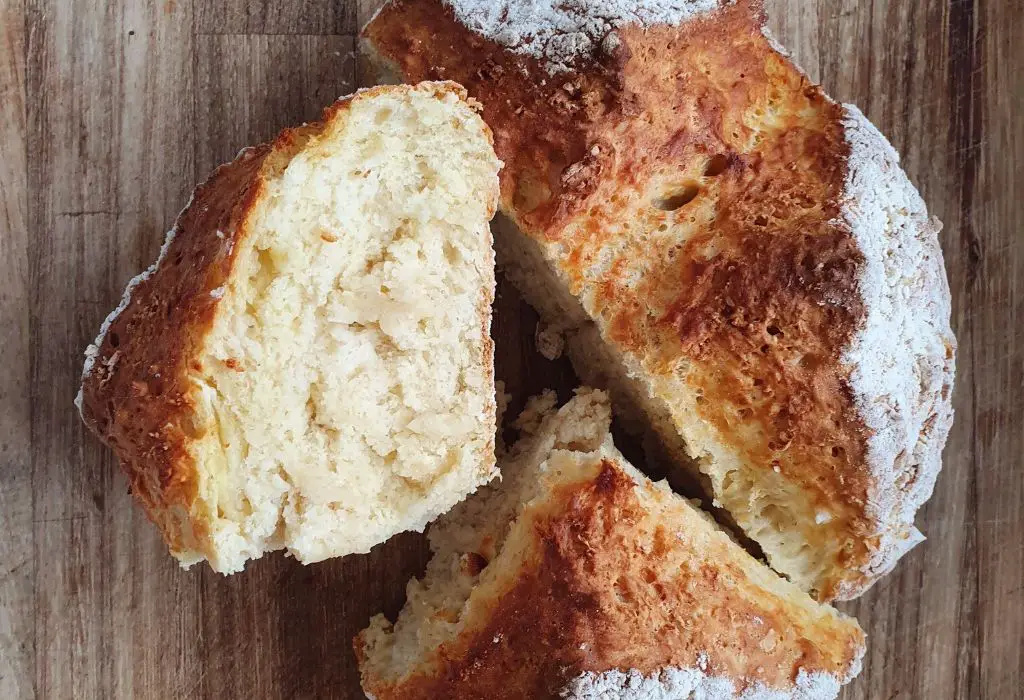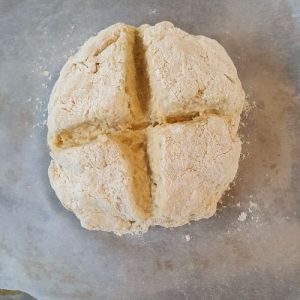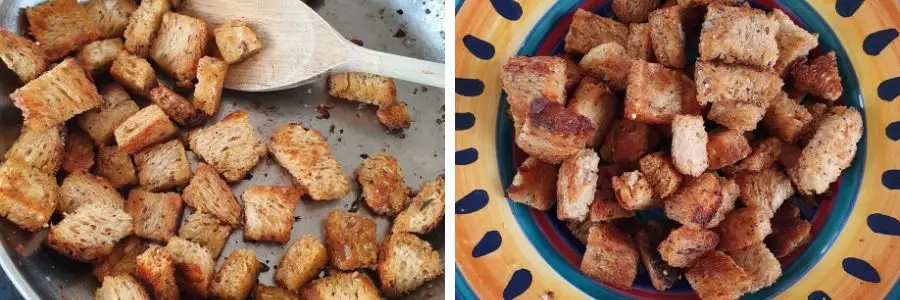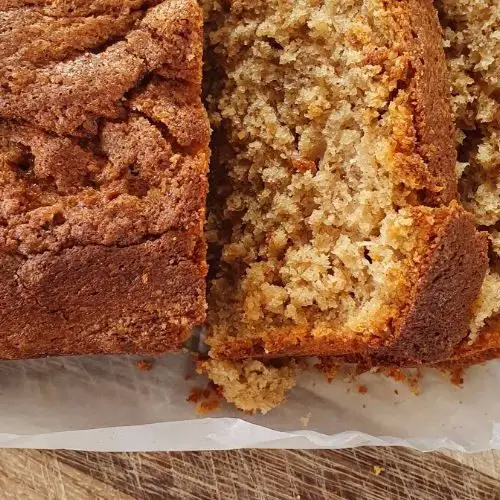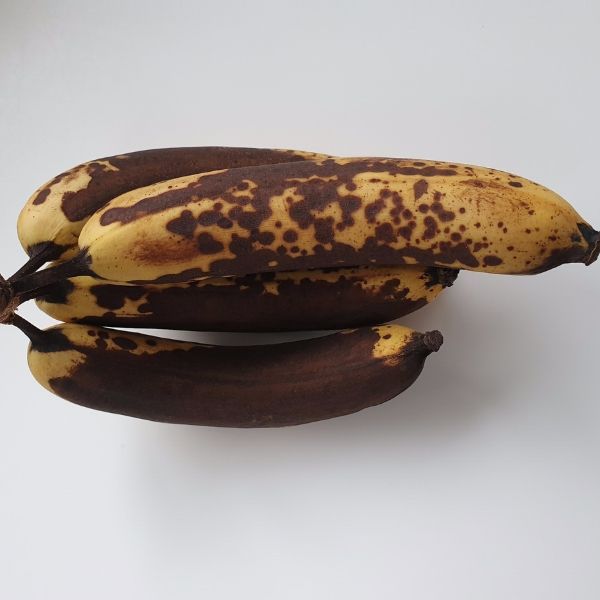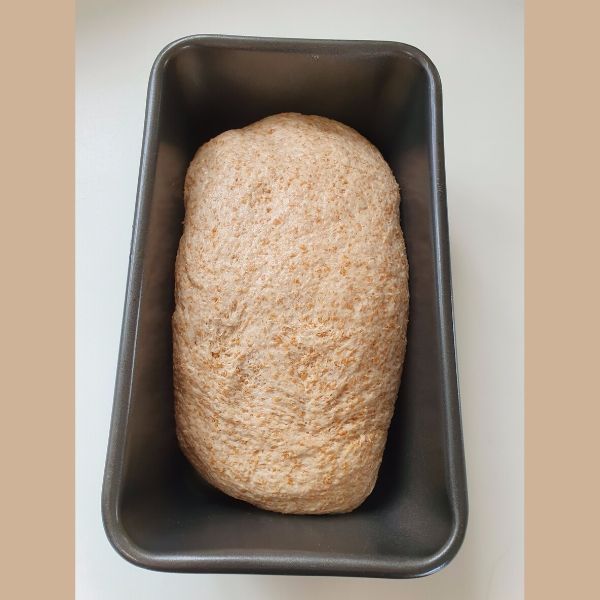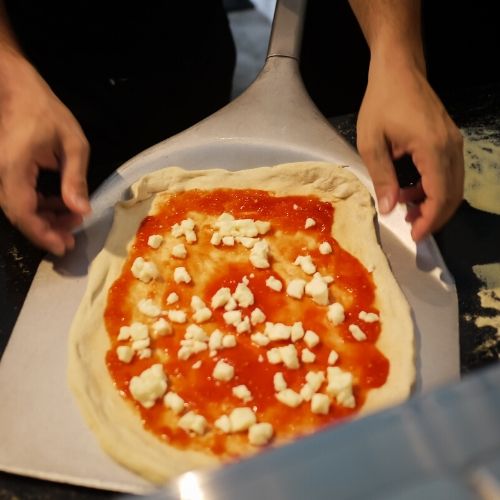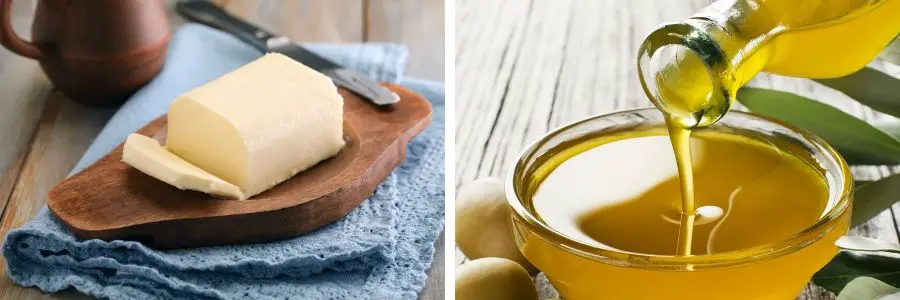In this post I’m going to show you how to make bread using a dough hook, along with a quick and easy bread recipe which you can use to make to make a simple white loaf from scratch using the dough hook.
Using a dough hook is a quick and easy way to make many types of bread and is especially good for sticky doughs which have a higher water content such as ciabatta.
Dough hooks can be attached to stand mixers and also hand mixers to assist with mixing and kneading the bread dough.
Read on for a step by step demonstration on how to make bread using a dough hook on a stand mixer along with tips and advice on how to choose the best mixer to use with a dough hook.
How to make bread using a dough hook with a stand mixer
Step 1 – Weigh the ingredients
Bread Ingredients
- 500g Strong white flour
- 7g Dried yeast
- 10g Sea salt
- 280-300ml Warm water
- 30g Butter
Method
- Place the mixer bowl on digital scales and weigh the flour, yeast and salt into the bowl, keeping the salt and the yeast separate from each other.
- Boil the kettle and place a jug on the scales, pour 100ml of boiling water into the jug and add the butter so it begins to melt and becomes soft. Then top up the rest of the water with cold water. The water should feel just warm.
- Make a well in the flour and pour in the water and butter mix.
Step 2 – mix the ingredients and knead the dough using the dough hook
- Place the bowl in the mixer stand and bring down the dough hook, start mixing on a low speed checking the dough consistency as it starts to come together. If it looks too dry at this point, you can add a little bit more water or if it’s too wet, a bit more flour.
- Once you’re happy with your dough, turn up the speed to around 1-2 (for a Kenwood stand mixer) and leave to knead for around 8 minutes.
Stop your mixer from moving around
Although it’s fine to leave your mixer to knead the dough for around 8 minutes while you get on with something else, keep in mind that if it’s on a shiny surface it may move bit by bit across the worktop.
I found mine on the edge once, which could have ended in disaster! To stop your mixer moving fold a tea towel and place it under the side of the mixer which is nearest to the edge of your worktop.
How do you know if dough is too wet or too dry?
If the dough is too dry it will look flaky and might not incorporate all of the flour at the mixing stage, if this is the case add a little of water at a time until the dough reaches a good consistency.
A regular dough recipe will stay around the dough hook as its mixing (see image below).
If the dough is too wet it will pool at the bottom of the bowl, some types of bread do require a wetter mix so this is not necessarily a problem unless the recipe requires a firmer dough such as a pizza.
The texture of the dough will change as you start mixing, it’s best to let it mix for about 30 seconds before you can really tell if it’s too wet or dry.
TIP: Not sure if you have all the necessary bread baking equipment at home? Check out my recommended picks below (Amazon links):
-
- Scale: Nicewell 22lb Digital Kitchen Scale
- Mixing Bowls: OXO Stainless Mixing Bowls Set
- Pastry Scraper: OXO Stainless Pastry Scraper
- Loaf Pan: OXO Non-stick Loaf Pan
- Kitchen Thermometer: ThermoPro Digital Thermometer
- Stand Mixer (optional): Kenwood Kmix Stand Mixer
Step 3 – Rise and prove the dough
- When 10 minutes is up, remove the dough hook and scrape any dough that’s stuck to the hook back into the bowl.
- Cover the bowl with cling film and leave to rise for at least an hour or until the dough has doubled in size.
- Once the dough has risen, scrape the dough out of the bowl using a dough scraper onto a floured or oiled surface.
- Flatten the dough out using your fists (but don’t punch the dough) to remove any large bubbles.
- Roll the dough up into either a round shape if you’re baking the bread on a baking sheet or a rectangular shape if you’re using a loaf tin, making the seam side of the bread is facing downwards.
- Slash the top of the loaf (about 0.5cm in) with a serrated knife and cover in something that won’t stick to the dough such as a clean tea towel or place inside a large plastic bag.
- Leave the dough to prove for another hour.
How do you know if the bread is proved?
Proving (or proofing) the bread is the process you need to follow to give the dough chance to rise for a second time.
For most bread recipes you will need to prove the bread in the shape it’s going to be baked in either on a baking tray or in a bread tin.
The proving process generally takes about an hour to complete and during this time the dough will increase in size by about 50%.
How quickly the does rises depends on many factors, including room temperature and the type of dough.
Under-proved dough will result in a dense loaf and over-proving will lead to a bread which is too light and fluffy. So you need something between the two.
You can test if your dough is proved enough by sticking your finger into the dough and if it doesn’t spring back all the way and a small indent remains, the dough is proved.
For more information on proving dough, you might find the following post helpful:
What is Dough Proving (proofing) and How to do it Properly
The image below shows an example of a dough before and after proving:
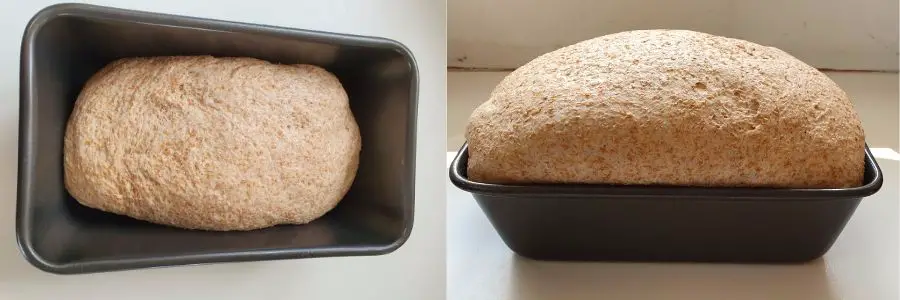
Step 4 – bake the bread
- Preheat the oven to 230°C/450°F.
- Place the bread in the oven and bake for about 30 minutes until the bread is golden brown and makes a hollow sound when you knock the bottom of the loaf.
- Cool the loaf on a wire rack and enjoy!
Stand mixers v’s Hand mixers with dough hooks
Using the dough hook/s attachments on a hand mixer is different to using the attachment on a stand mixer, there are pros and cons each type of mixer which are outlined below.
The dough hook on the stand mixer is usually a hook shape and there’s only one of them. For a hand mixer the dough hooks are generally a spiral or corkscrew shape and there are usually two of them.
Stand mixer with bread hook V’s…
- High power machine which does all the work.
- Long term investment which will last for many years.
- Can be used with other attachments for many baking tasks.
- You can do something else while the dough is kneading.
- Higher initial cost outlay
- It’s a bulky item for a small kitchen
Hand mixer with bread hooks
- Lower initial cost outlay
- Takes up less space in the kitchen
- Can be used with other attachments for many baking tasks
- Less power behind the mixer
- You have to hold the mixer throughout the process
- Can be a battle to hold the mixer especially with firmer doughs
Which stand mixer is best for kneading dough?
My recommendation – the Kenwood Chef
There is a lot of choice out there when it comes to stand mixers, thanks to shows such as Bake Off they have become a trendy kitchen accessory which people pay a premium for to get it in a certain colour.
There are various options when it comes to choosing a stand mixer, including power (wattage), accessories and bowl capacity.
For me, the best stand mixer is a Kenwood Chef, I’ve had mine for about 15 years now and it just keeps on going, before then I used my mums which I think she’d had for even longer.
The current version of the standard Kenwood Chef comes with a dough hook, a whisk attachment and the ‘K’ attachment which is good for beating ingredients such as buttercream. It also comes with a large mixing bowl which is perfect for bread making.
With a wattage of 1200 for the standard Kenwood Chef (Amazon link), there’s plenty of power to produce excellent dough results, the upgraded ‘Titanium’ version (Amazon link) offers more power again at 1700 watts, but comes with a higher price tag.
Click the link below to view the Kenwood Chef at Amazon and to see the latest prices:
Shop or check prices of the Kenwood Chef here.
For more information on how the Kenwood Chef and a comparison of the different models, take a look at the following article:
Kenwood Chef for bread dough – video instructions and machine reviews
Best budget hand mixer to use with dough hooks
My recommendation – Bosch hand mixer
Many hand mixers now come with dough hooks as standard, but if the mixer its self hasn’t got much power behind it, then you will have a ten minute battle with the mixer and the dough and it would probably be much easier just to knead the bread by hand.
I recommend the Bosch hand mixer (Amazon link) because for a small machine, it has a decent amount of power behind it with a wattage of 450.
It comes with dough hooks as standard along with beaters which are perfect for cake baking.
Check the version which you are looking to purchase to make sure the wattage is 450.
There are some cheaper Bosch hand mixers available (Amazon link), however they will have a lower power which will struggle with bread making.
Summary
I hope this post has given you some tips on how to make bread using a dough hook. You may also like the following articles:

